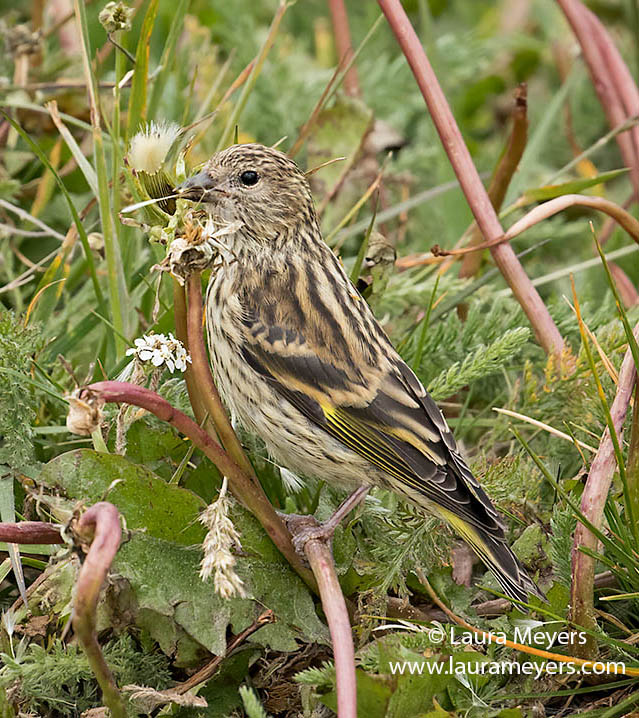

Normally birds that migrate have a tendency to return to the same area year after year to nest. They may nest in one area one year, then the following year they may choose a site hundreds of miles away. Pine Siskin are quite nomadic in their nesting habits. She will feed them insects, but once they have left the nest seeds will become the main diet. After the eggs have hatched the young Siskin will remain in the nest for another 15 days before fledging. While she is on the nest the male will feed her. The down she has lined her nest with will help keep the eggs warm during these short trips from the nest. The female will then continuously incubate the eggs for 13 days leaving only for very brief periods. Once the female has completed the nest she will lay 3 to 5 greenish blue eggs with black and brown spots. Being somewhat of a communal species there will commonly be a number of Pine Siskin nesting within a few feet of each other, often visiting each others nest. The nest is concealed far out on the end of a tree branch as high as 50 feet above the ground. They are monomorphic meaning that both sexes have a similar appearance.ĭuring the breeding season the female will build a nest in the shape of a shallow saucer made of twigs, grasses, and rootlets lining it with soft hair, feathers and thistle down.

The tail is slightly notched and the bill, longer than that of a Goldfinch, is slender and pointed. These yellow patches are not always visible when they are in their basic plumage. Siskin have two white wing bars along with yellow patches on the wings and rump. It is slightly smaller than the Goldfinch, averaging just a half ounce in weight, with a brown body and dark streaks. The Pine Siskin is a small finch that reminds me of a dark goldfinch with stripes. That is when Pine Siskin drift south in search of food during the winter. This correlates with a low production of seeds in the north about every two years. It seems as it is every two to three years they appear in large numbers. These visits in the winter by Siskins are cyclic and likely related to the annual seed production in the northern forests. This southward movement of northern birds during the winter months is known as an irruption and the Pine Siskin are the most common of the irruptive winter finches.

Some years they may appear as far south as Tennessee and Arkansas and beyond. They wander south throughout the United States during the winter months in search of available food resources. Their preferred northern habitats are the coniferous and deciduous forests and woodlands in the threatened Boreal Forests to the north. They are also common in the higher elevations of mountainous areas in the Rockies and western states. Many of these birds breed from southern Alaska across Canada to Newfoundland down to the upper Great Lakes region and over to northern New England. A favorite winter bird that generally arrives in the Midwest and Great Plains states in late November to early December that has a huge appetite for Nyjer seed at our thistle feeders is the Pine Siskin.


 0 kommentar(er)
0 kommentar(er)
